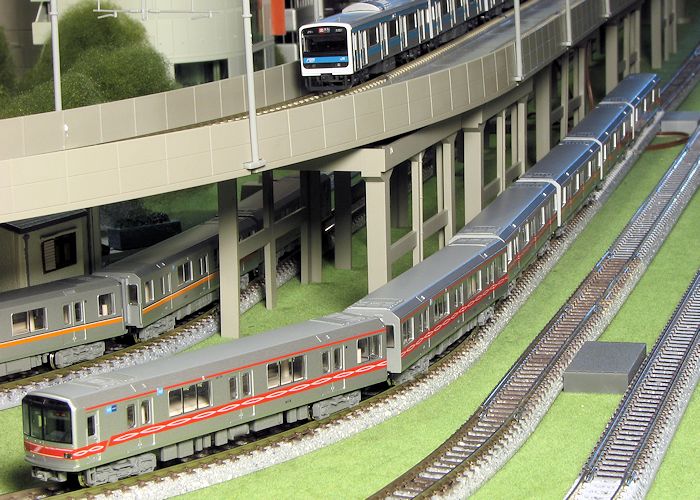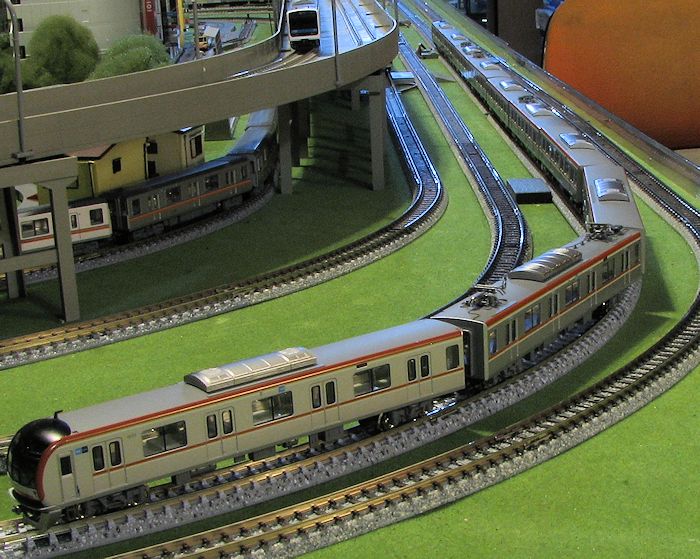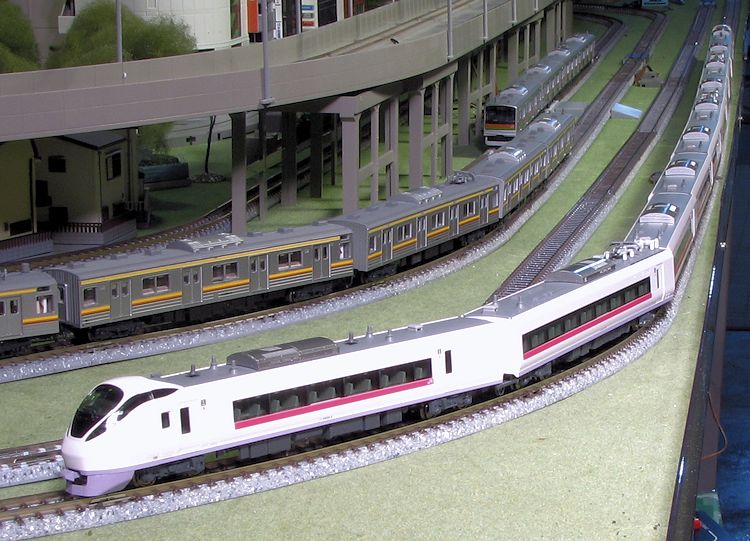 Not
a whole lot has changed since the last installment. Every scouring the sales
pages, I found another rather neat train and one that adds to my Tokyo Metro
collection. This is a
Marunouchi Line set. This was the second subway line built
in Tokyo city, though it was a post war construction. Like the Ginza Line
trains, these are smaller than the norm and operate on a third rail electrical
system. In the photo you can see the Ginza Series 01 train in the background
with the orange stripes. The Marunouchi trains are known as Series 02 trains and
this set represents the overhauled trains, which can be identified by the 'sine
wave' markings on the side of the main red bands on each car. These are also six
car sets and the train is produced by Kato (pronounced 'cat- oh').
Not
a whole lot has changed since the last installment. Every scouring the sales
pages, I found another rather neat train and one that adds to my Tokyo Metro
collection. This is a
Marunouchi Line set. This was the second subway line built
in Tokyo city, though it was a post war construction. Like the Ginza Line
trains, these are smaller than the norm and operate on a third rail electrical
system. In the photo you can see the Ginza Series 01 train in the background
with the orange stripes. The Marunouchi trains are known as Series 02 trains and
this set represents the overhauled trains, which can be identified by the 'sine
wave' markings on the side of the main red bands on each car. These are also six
car sets and the train is produced by Kato (pronounced 'cat- oh').
 The
next additions are not a full train, but an add-on set. This is also for part of
the Tokyo Metro and is for the
Fukutoshin
Line's Series 10000 of trains. Back when I bought the basic 6-car set, I did
not get the add-on four car set to make a standard ten car train. As luck would
have it, when I went to pick it up, it was no where to be found. Recently this
set was reissued, but this time Kato decided to do another set of serial numbers
and divided it into three different sets of 3,3, 4. What it meant is that even
if I bought the four car set, the serial numbers would be wrong so I needed the
additional four car set to go with the set I bought. I finally located the proper set
and so was able to pick it up and add it to the train. This leaves just one
train for which I need the add on set and so far, I have not been able to find
it. These things generally seem to show up at one time or another so it isn't a
big rush.
The
next additions are not a full train, but an add-on set. This is also for part of
the Tokyo Metro and is for the
Fukutoshin
Line's Series 10000 of trains. Back when I bought the basic 6-car set, I did
not get the add-on four car set to make a standard ten car train. As luck would
have it, when I went to pick it up, it was no where to be found. Recently this
set was reissued, but this time Kato decided to do another set of serial numbers
and divided it into three different sets of 3,3, 4. What it meant is that even
if I bought the four car set, the serial numbers would be wrong so I needed the
additional four car set to go with the set I bought. I finally located the proper set
and so was able to pick it up and add it to the train. This leaves just one
train for which I need the add on set and so far, I have not been able to find
it. These things generally seem to show up at one time or another so it isn't a
big rush.
I also added four cars to the Series 485 'Hibari'
limited express train that I have, making for a full eleven car train. See the previous
installment for a photo of that particular train.
One change that I have made to the layout is to remove
two of the double crossings. These are nice to have, but as I have the points
unpowered, they have a tendency to de-rail some of the longer trains. As that
was a hassle, I removed these features, though should I ever rig up a power and
switch set up for these, I'll reintroduce them. If you look down the track in
the image above, you'll see that they are gone. I also shortened the second line in and put the turnouts on the outer line. This way, the train runs in a manner that there will be no instance of a train accidentally heading up a turnout, something that has happened in the past. I'll run a photo in the next installment.
 I got a good deal on another limited express so picked it up. This is the
E657 Series
'Super Hitachi', one of the more modern trains on the rails in Japan. While the
US talks about 'high speed rail', the truth is that what is being projected is
nothing like the Shinkansen trains in Japan or the TGV in Europe, but more along
the lines of the slower limited express trains like this. This is a Kato set and
required the usual purchase of three sets to make up the entire ten car train.
This set represents the first one in service, which started in early 2013.
I got a good deal on another limited express so picked it up. This is the
E657 Series
'Super Hitachi', one of the more modern trains on the rails in Japan. While the
US talks about 'high speed rail', the truth is that what is being projected is
nothing like the Shinkansen trains in Japan or the TGV in Europe, but more along
the lines of the slower limited express trains like this. This is a Kato set and
required the usual purchase of three sets to make up the entire ten car train.
This set represents the first one in service, which started in early 2013.
Another thing I picked up was a wheel cleaner. The
rails will eventually get some gunk on them as a result of minute arcing as the
power transfers from the rails to the wheels and then to the motor. There is
also one for unpowered wheels. Interestingly, from what I gather, these are dry
cleaners and one does not use any sort of liquid on them. So far, they are
pretty dirty and I've not a clue how to clean the cleaners as isopropyl alcohol
does not seem to do anything!
If you are reading this then there is a good chance
that you either have a layout or are at least interested in trains. Should you
run N gauge, send a photo. I'm sure few of you have interest in Japanese
passenger trains, but it is still neat to see what others are doing in the space
allotted.
Back to Silver Rails index
 Not
a whole lot has changed since the last installment. Every scouring the sales
pages, I found another rather neat train and one that adds to my Tokyo Metro
collection. This is a
Marunouchi Line set. This was the second subway line built
in Tokyo city, though it was a post war construction. Like the Ginza Line
trains, these are smaller than the norm and operate on a third rail electrical
system. In the photo you can see the Ginza Series 01 train in the background
with the orange stripes. The Marunouchi trains are known as Series 02 trains and
this set represents the overhauled trains, which can be identified by the 'sine
wave' markings on the side of the main red bands on each car. These are also six
car sets and the train is produced by Kato (pronounced 'cat- oh').
Not
a whole lot has changed since the last installment. Every scouring the sales
pages, I found another rather neat train and one that adds to my Tokyo Metro
collection. This is a
Marunouchi Line set. This was the second subway line built
in Tokyo city, though it was a post war construction. Like the Ginza Line
trains, these are smaller than the norm and operate on a third rail electrical
system. In the photo you can see the Ginza Series 01 train in the background
with the orange stripes. The Marunouchi trains are known as Series 02 trains and
this set represents the overhauled trains, which can be identified by the 'sine
wave' markings on the side of the main red bands on each car. These are also six
car sets and the train is produced by Kato (pronounced 'cat- oh'). The
next additions are not a full train, but an add-on set. This is also for part of
the Tokyo Metro and is for the
The
next additions are not a full train, but an add-on set. This is also for part of
the Tokyo Metro and is for the
 I got a good deal on another limited express so picked it up. This is the
I got a good deal on another limited express so picked it up. This is the